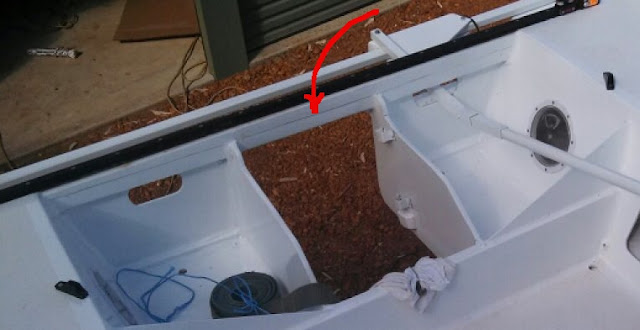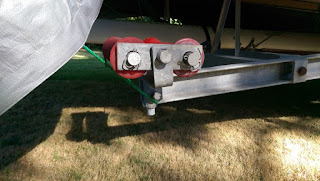| Product | Price | Qty | Subtotal |
|---|---|---|---|
| 316 STS CSK PHIL: #10 X 3.1/2 | 0.85 | 10 | 8.50 |
| 316 STS CSK PHIL: #10 X 3 | 0.73 | 10 | 7.30 |
| 316 STS PAN PHIL: #10 X 1/2 | 0.14 | 10 | 1.40 |
| 316 STS CSK PHIL: #12 X 1/2 | 0.22 | 10 | 2.20 |
| 316 STS PAN PHIL: #12 X 5/8 | 0.20 | 10 | 2.00 |
Essentially it's enough stainless steel screws to hold the rear traveller down into every layer of timber on the transom - regardless.
The 'I' section traveller (for the main sheet) on the transom is Ronstan I-Beam 19 and is 24mm high.
There is a 7mm gap to the top piece of timber of the transom.
The top piece of timber is anywhere from 35mm to 25mm high (35mm in the middle - the highest load point).
The lower section of the transom is about 40mm high.
So 24+7+35 = 66mm
To make the screw "bite" all the way to the lower part of the transom my 3 1/2" (or 88mm) screws will give around 22mm of penetration.
I'll use the 76mm screws as the top timber gets thinner.
All screws will be epoxied in. If I ever have to remove it - well I'll cross that bridge...
By the way. The existing screws are 50mm long - losing 30mm before they hit timber. The two I tried this morning are modestly thumb and forefinger tight with traces of silicone on the threads - and NO NYLON INSERTS. It's stainless steel on aluminium. (There are nylon inserts on the Jib sheets travellers - I have found several sources of them online.)
My next challenge is where to get 7mm deep hardwood about 35-30mm wide.
Hopefully I'll get to that over the Christmas new year break. I've found a couple of timber machinists and custom molding places reasonably nearby. (I only have a manual power plane and I'd have to take 10mm down to 7mm evenly for a couple of meters - not likely - but possible.)
The #12 screws are for the rudder box lower gudgeons where you can't use bolts. (They were 6g countersunk with flat washers and were almost useless).
12g screws are 5.5mm to the outer part of the thread so should hold a lot better.
I got Countersunk (CSK) and Panhead (PAN) just in case one works better than the other. The 5/8" might just fit with a flat washer under them. The rudder box timber is 12mm, the gudgeon 2mm so I'd have to take up another 1.9mm to stop the screw poking through. If if doesn't look right I'll use the 1/2" (I'll check before screwing the 5/8" in).

















